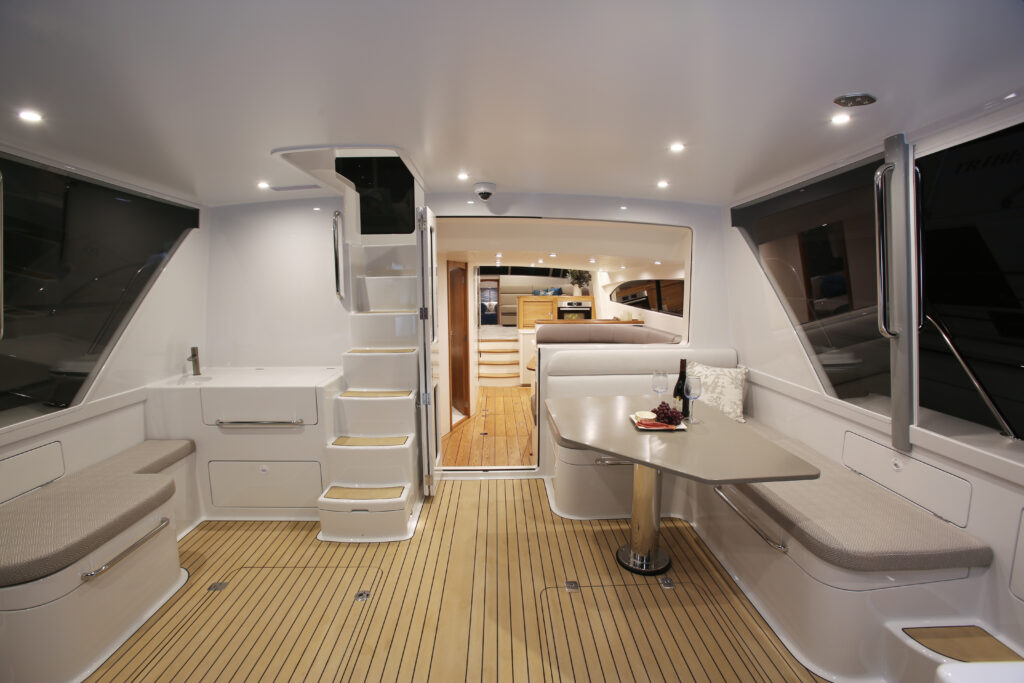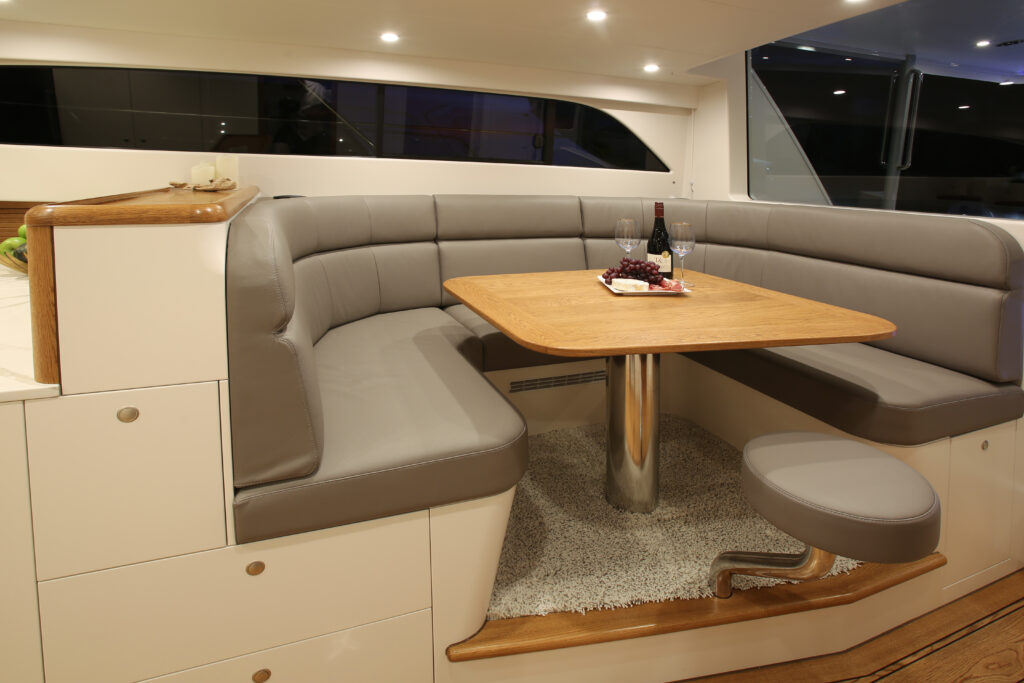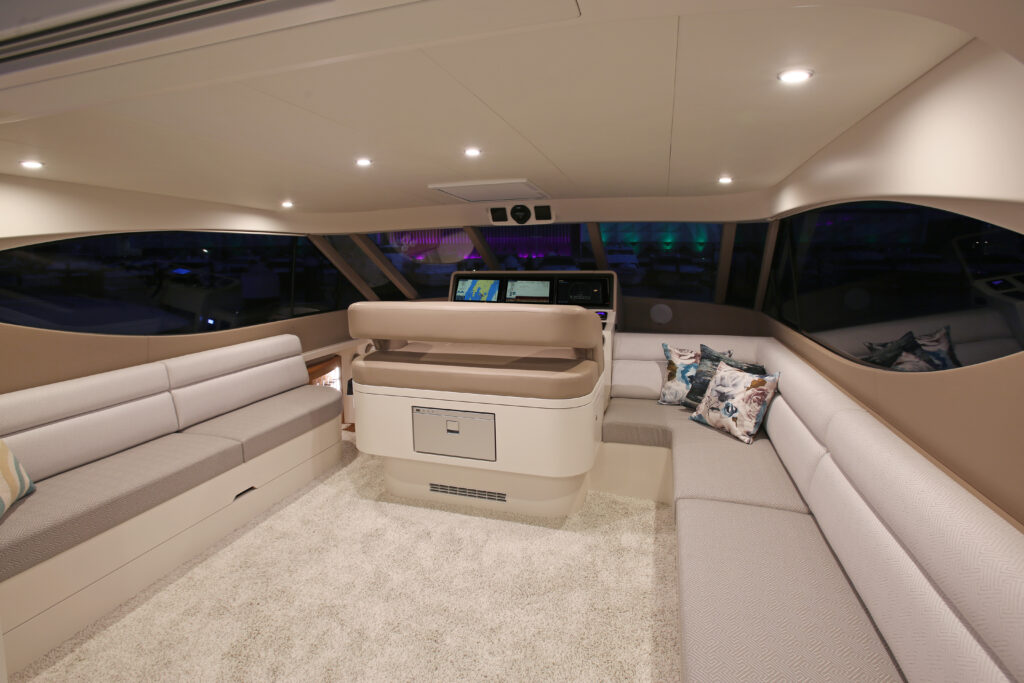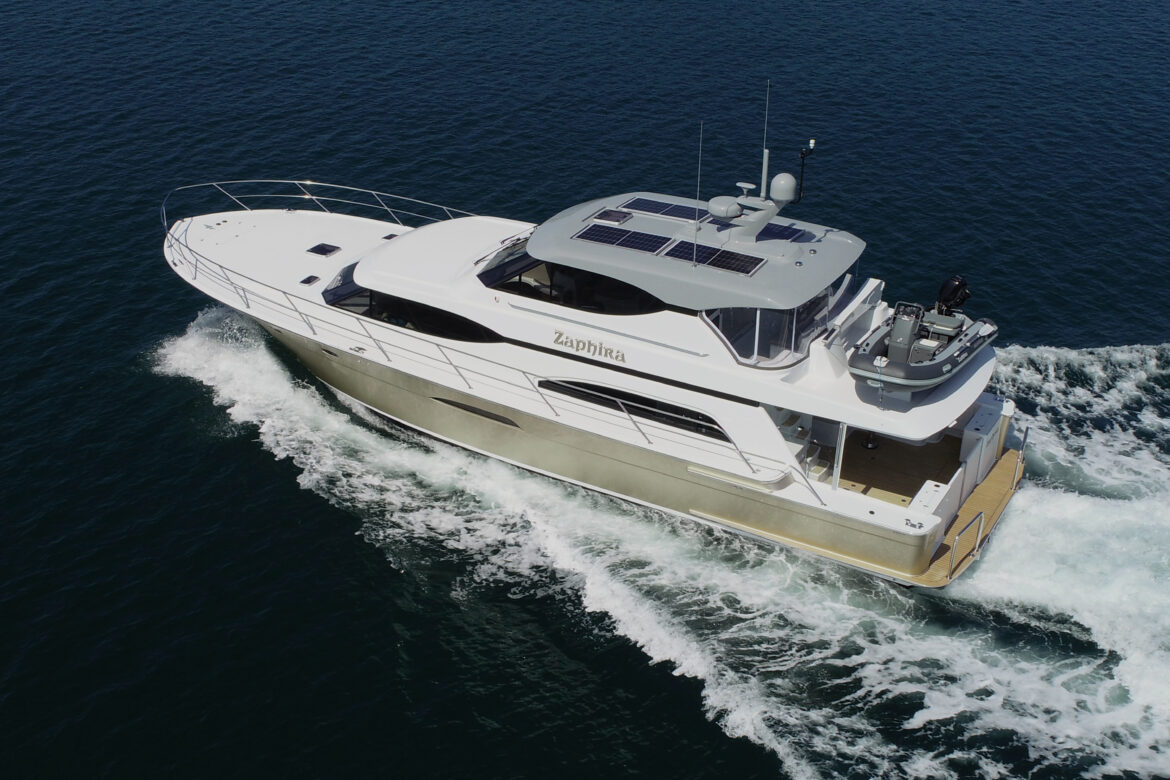With gold-bronze metallic paintwork and an elegant, balanced profile, the 18m Upfold Elite mid-pilothouse Zaphira by Lloyd Stevenson Boatbuilders, cut quite a dash in the Bay of Islands on her summer cruise. Like many Upfold owners, Rod and Gae of Zaphira are repeat customers for obvious reasons – and not so obvious.
Sure, Zaphira looks styley, the mid-pilothouse concept is hugely successful and the customised interior perfectly suits Rod and Gae, but ultimately the enjoyment and value in boat ownership are in the ease of operation, so for this review I’m taking a different approach. We’re heading below decks to the heart of Zaphira: the engine room. It’s a favourite place for Rod, too – and so it should be, says Benji Saynor, head engineer at Lloyd Stevenson Boatbuilders. ‘We don’t just design the engine room for practicality,’ says Saynor, who joined Lloyd Stevenson Boatbuilders 16 years ago. ‘We do it for looks as well. It’s got to be a show piece. It should be that the owner can take a mate down there and show it off like he shows off his car in his garage.’ Awww. Now motoryacht owners around New Zealand know that someone understands them. It gets better, because Saynor is just loving the twin 800hp MAN 588kW engines. ‘MAN are beautiful looking engines. I’ve always said that,’ he says. ‘They are super quiet. It’s the first time I’ve ever worked with MAN engines and I’d love to install more.’ Quietness was a major reason why Upfold and Stevenson selected MAN, having seen and barely-heard the twin MAN engines operating in the Upfold Elite 18m Sportfisher Peregrine and 18m Sportfisher Crazy Diamond. ‘The MAN engines are smooth and quiet, especially at idle and start-up,’ Upfold says. That’s especially relevant in a mid-pilothouse configuration which sites the engines under the saloon sole. But, enough MAN love.

Apart from aesthetics, the engines’ installation is designed to enhance their smooth running. ‘We have the 30.5-inch x 32.5-inch propellers on a 2.5-inch drive shaft which couples to a thrust bearing,’ he says. ‘From that we use a cardan or universal shaft which links to the back of the Twin Disc Quickshift transmission. Effectively, we’ve taken all the thrust from the propeller and pushed it all into the structure of the boat through the thrust bearing. This takes the thrust load off the engine and makes for a much smoother ride on the boat.’ Zaphira’s 1600hp gives her a planing speed of around 15 knots and a top speed of 30 knots at 2300rpm. Rod generally cruises Zaphira at around 15-18 knots. For our run on Zaphira, we had calm conditions, but Rod recounts a trip home from Kawau Island to Sandspit in a 1.5-2m swell in beam seas at 20 knots. ‘So it was a bit of a rocky ride, but Zaphira just kept going,’ he says. Upfold has designed the hull with his signature silent chines in a warped planing hull with diminishing deadrise aft. This suits the mid-pilothouse boats because, as dictated by the layout, the engines are well forward. The diminishing deadrise reduces displacement aft to keep the boat at optimum trim, fore and aft. ‘It is an easily pushed hull,’ Upfold says. Rod and Gae were happy that they cruised from Sandspit to the Bay of Islands using half the amount of fuel of a similar-sized, heavier flybridge boat travelling at the same speed. As for boat handling at low speeds, Rod and Gae are even more comfortable with Zaphira than their previous Upfold Elite 16m Maeve, thanks to EJS (Express Joystick System).
Zaphira has bow and stern thrusters, twin propellers and throttles, but managing them together demands a high degree of multi-tasking. Zaphira has EJS on her flybridge helm and the auxiliary helm, port-side on the aft flybridge deck. With the EJS function engaged, the skipper moves the joystick to reflect how he/she wants the boat to move, and the EJS makes it happen. It has three modes: docking, hold and drift. The EJS docking mode works as described above. In EJS hold mode, the EJS uses the GPS to hold the boat stationary, regardless of wind and tide. It’s handy for arranging fenders and dock lines before entering a marina, especially singlehanded. If there’s a sticky moment in berthing, the skipper can hit ‘hold’ while planning the exit strategy. The EJS drift function is primarily for fishing. The skipper sets a heading and allows the boat to drift with wind or current at the designated drift speed. ‘This EJS was the first we’d fitted ourselves,’ says Stevenson. ‘Normally the boatbuilder would buy the system and Twin Disc would supply all the rubber hoses at the lengths provided, but Benji decided to install solid stainless tube instead. He used flexible hose only for the connection to each component. When the EJS representative signed it off, he wrote that it was probably the best installation of an EJS system he had seen for a long time.’ Saynor used stainless steel pipes instead of hoses for longevity and because it enables a quieter system with better hydraulic pressure. The installation is immaculate and out of sight, as the engineers were able to schedule their work with the builders as the engine room took shape – an advantage of a custom build in which nearly every part of the boat is built in-house. In engine room décor, bulky exhaust systems are, well, bulky. ‘It is quite an elaborate system,’ Saynor says. ‘It is a wet exhaust system, [meaning that it uses water to cool the exhaust gases] but to incorporate the air vents we had to run a dry exhaust system to start off with, then we run a water mixer which cools the gases and then exits underwater through the hull. That was many man hours in design and fabrication, of which 99 per cent was done in-house by engineer Sam Hill.’ Sparkling white engine rooms require housework. Zaphira has a fully plumbed Wetvac system and hot and cold water on tap for cleaning and hand washing.
The MAN engines have electric oil pumps which ensure clean oil changes. Any leaks of hydraulic oil can be identified as relating to either the EJS system, dinghy davit or steering system by its colour pigment of red, blue or standard yellow. Lloyd Stevenson Boatbuilders is big on easy maintenance. ‘We service 95 per cent of our own boats,’ Stevenson says, ‘so when the boys are fitting out the boat, they’ve got future servicing in mind. Anywhere there is a join or something that needs to be serviced, it is accessible without needing specialist tools,’ says Saynor. Both engines run off a main diesel tank of 4400 litres, supported by two long range integral tanks of 800 litres per side, giving a total capacity of 6000 litres. Diesel can be transferred between tanks with a reversible pump managed by CZone. It means Rod and Gae can cruise for several weeks without refuelling. Also with long term cruising in mind, Zaphira has a 240V DC water pump for the main house fresh water system, with a back-up pump connected to the watermaker, requiring only a turning of a valve in the engine room to bring it into service.

Another piece of equipment taking care of business is the Onan 18kW generator in the lazarette. Zaphira has four Mastervolt lithium ion 24-6000 house batteries providing up to 920 amp hours capacity. If the batteries are getting low while the boat is at anchor, the generator starts automatically, then shuts down when the batteries are charged to a certain percentage.
To reduce generator time, Zaphira has solar panels, installed out of sight below the lip of the flybridge roof. The antennae mast was designed without wings as their shadow would have seriously compromised the solar panels’ power output. On cold days, an Airtronic diesel heater in the engine room is ducted to warm the galley, flybridge helmstation, main saloon and forward cabin. Rod and Gae love their boat’s features. ‘When you get a new boat, you want to have as much new technology as you can, as it is quickly outdated,’ Rod says. The systems are easily managed with full AC/DC CZone which allows control of all electrical systems via touch screen. A central monitoring app allows Rod and Gae, Saynor and Lloyd Stevenson Boatbuilders’ electronics expert Angus Small to monitor Zaphira’s status in aspects such as battery, water and fuel capacity, and details such as speed and position anywhere in the world. Anyone authorised to use/access the app, including the owners or designated Lloyd Stevenson Boatbuilders staff, can manage the boat’s systems such as power generation or switch on the fridges prior to a voyage. As a mid-pilothouse, Zaphira’s layout is similar to other Upfold Elite models such as Antiquity, Maeve and Vanquish. However, every boat can be customised to the exact owners needs. This includes interior and exterior styling and layout.

On Zaphira, the cockpit welcomes with al fresco dining to starboard, closely associated with a doorway and electric, receding window to the inside dining. To port, is a double cabin with ensuite/day head. The galley is for’ard to starboard with lots and lots of chef accoutrements: boiling water on tap, bulk stowage in a locker beneath the sole, a full size domestic fridge with a discreet safety lock, microwave/convection oven, dishwasher and stunning stoneware bench. Steps lead up into the saloon where seating includes twin recliner chairs to enjoy TV and delicious almost all-round views. To port, aft, steps lead between glassware cabinets to the flybridge helmstation with more seating and an enclosed Juliet balcony, also home to the auxiliary helm. Forward from the saloon, steps lead down to the accommodation: a for’ard master cabin and ensuite, and the second guest cabin to starboard with a single and double bunk, stacked, and access to the engine room.
When I visited Zaphira in the Bay of Islands, it was less than a year since her launching. I arrived on Emperor, the 14.5m mid-pilothouse owned by Bill and Christine Upfold since Upfold built her in 1989. It was a worthy comparison. Although Emperor is without the modern advances such as CZone and EJS, she has been well maintained and her fundamental systems in engineering, electrics and plumbing, with some upgrades, continue to operate smoothly, more than three decades on. Upfold’s attention to design and installation is fundamental to happy, successful boat ownership. It’s continued in the workmanship of Lloyd Stevenson Boatbuilders, as on all its builds and is a sure reason why customers keep coming back.


SPECIFICATIONS
- Construction Balsa core, E glass epoxy composite
- LOA 18m
- Beam 5.4m
- Draft 1.2m
- Displacement 28,000kg
- Deadrise 11 to 26 degrees
- Fuel 6000L
- Engines 2 x MAN i6 @ 800hp/
- Twin disc MGX 5096a
- Drive Shaft
- Fuel capacity 4,400lt (6,000lt extended range)
- Gearboxes Twin Disc Quickshift
- Genset Onan 18kW
- Water capacity 900lt, plus 210 l/hr Watermaker
- Hot water capacity 200 L
- Holding tank 300L
- Cruising speed up to 25 knots
- Max speed 29.5 kt (fully laden)
| Performance Data | ||||
| RPM | Fuel | Speed | L/nm | Range |
| 900 | 27 | 8.8 | 3.1 | 1760 |
| 1200 | 66 | 9.7 | 6.8 | 794 |
| 1400 | 98 | 13 | 7.5 | 716 |
| 1600 | 133 | 16.3 | 8.2 | 662 |
| 1800 | 172 | 20 | 8.6 | 628 |
| 1950 | 206 | 22.8 | 9 | 598 |
| 2150 | 272 | 26 | 10.5 | 516 |
| 2300 | 308 | 28 | 11 | 491 |



